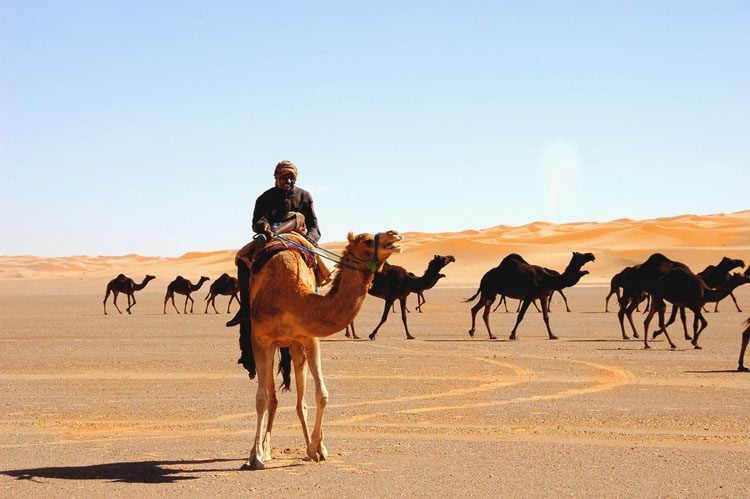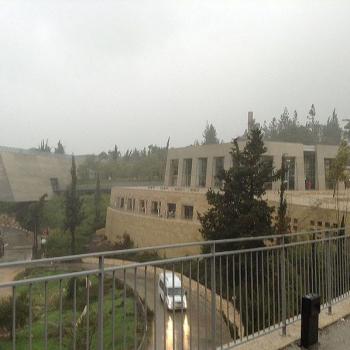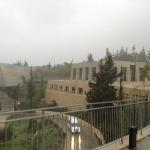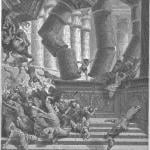
(Wikimedia Commons photo by Mohammad Nowfal)
Another few hundred words:
It was at Nahom, incidentally, that Lehi and his party abruptly turned due east after their long period of travel along the coast of Arabia in a southeasterly direction. A glance at the map shows that by doing so, they missed the area of what has long been known as Yemen. Instead, they moved along behind the mountains that form the natural division between Yemen and the rest of the Arabian peninsula. (Most of Yemen is mountainous. The tallest measured peak is 12,336 feet high.) This may or may not have been deliberate. But I suspect that it was, and for several reasons. First of all, whether they knew it yet or not, they needed to find a place in which they could find shipbuilding materials. Few such places exist, so the direction of their travel had to be quite deliberately chosen. (Whether it was chosen by the travelers themselves or by the Lord, for them, is immaterial.) But Lehi may well have wanted to avoid the relatively civilized area of Yemen, the ancient Sheba. For one thing, it would have constituted a real temptation to his sons Laman and Lemuel, for whom he still had some faint hope. For another, Yemen represented the Arabian end of the major frankincense trail. There could well have been Jewish merchants there, and, if Hugh Nibley is correct in asserting that Lehi himself came from a merchant background, there might have been people in the towns of Yemen who would actually have known him.[1] Given the circumstances of his escape from Palestine, including the death of Laban, it might have been unwise to have met such people. Even Lehi’s vision of the Tree of Life may suggest something of the image that wealthy, mercantile Yemen could well have had in his mind. The “great and spacious building,” standing “as it were in the air, high above the earth” and “filled with people . . . [whose] manner of dress was exceedingly fine,” seems very like the ancient “skyscraper” architecture of Yemen. These multi-story Yemeni buildings, many of which still stand, have no windows on the ground floor, so as to be less vulnerable to thieves and robbers. At night, or in the “mist of darkness” reported by the prophet, it would indeed seem that the people who leaned out of the windows “in the attitude of mocking and pointing their fingers” were in a building that floated “as it were in the air, high above the earth.”[2]
Thus, Arabia and the Arabs play an important role in the early portion of the Book of Mormon. They figure prominently in the other scriptures as well. Some of the mountains of northwest Arabia, for example, are volcanoes that are now reckoned to be extinct (although eruptions are recorded into medieval times). Some scholars have seen in the smoke and fire and earthquake of Mount Sinai a description of a volcanic eruption (Exodus 19:18) and have argued that Moses’ reception of the stone tablets of the law actually took place in what is today Saudi Arabia, rather than at the traditional site in the Sinai Peninsula.[3]
It isn’t certain just when the Arabian peoples first appear in history. As early as 854 B.C., an inscription of Shalmaneser III mentions “Gindibu the Arabian,” who had assembled a camel corps to oppose the Assyrians. In the very south of the Arabian Peninsula, an advanced civilization seems to have developed as early as 1200 B.C., although we’re only now beginning to have some idea about it. The island of Bahrayn, off the eastern coast of Arabia in the Persian Gulf, may be the ancient Sumerian Dilmun. The genealogical tables in the Old Testament include recognizably Arabian groups among the children of Cush, Aram, and Eber, as well as among the children of Abraham by Keturah and by Hagar.[4] The complexity of the situation is increased by Arabian peoples being known throughout the Old Testament by a number of different (and occasionally puzzling) names, including, most prominently, Ishmaelites, Midianites, Dedanites, and Sabeans. It isn’t easy in the present state of our knowledge to reconcile all of these accounts, but we know that they contain truth because many of the names can be plausibly related to known peoples and places in Arabia.
The Hebrew word Arab properly means “nomad,” which tells us a great deal about these early people.[5] The description of Ishmael, in Genesis 16:12, as “a wild man,” whose “hand will be against every man, and every man’s hand against him,” well describes the life of the nomad, who has been famous from the beginning of history for his raids against settled folk.[6] It was a group of Sabeans—listed above as an Arabian people—who raided Job’s lands, killing his herdsmen and riding off with his cattle as booty.[7] This is the kind of life (though possibly without the thievery) that Ishmael seems to have led, wandering the desert and dwelling in a tent. “And God was with the lad; and he grew, and dwelt in the wilderness.”[8]
[1] In the period just prior to the rise of Islam, a Jewish kingdom was actually established for a brief time in southern Arabia. And persecuted Jews often fled to Arabia even at that relatively late time. See Shmuel Safrai, in Ben-Sasson, A History of the Jewish People, 358-359, 380. [Insert Nibley reference.]
[2] 1 Nephi 8:23, 26-27.
[3] Galatians 4:25 places Mount Sinai in “Arabia.” But, since even the traditional Sinai falls within the biblical definition of that term, this probably means nothing.
[4] Genesis 10:7, 23, 25-30; 25:1-4, 13-16.
[5] Later, in the Arabic language itself, the Qur’an contrasts the settled peoples of the oases with the nomads, whom it terms “Arabs.”
[6] The Amalekite raid on Ziklag recorded in 1 Samuel 30 is a good example of this, as is the Arabian raid that carried off Jehoram’s family and possessions, mentioned in 2 Chronicles 21:16-17, 22:1. (In Psalm 83, the Ishmaelites and the Hagarenes are depicted as the hereditary enemies of Israel.) Such raiding provoked pursuit, and the oracle of Isaiah 21:13-17 seems to be addressed to a group of fleeing Arabs.
[7] Job 1:15.
[8] Genesis 21:20.











